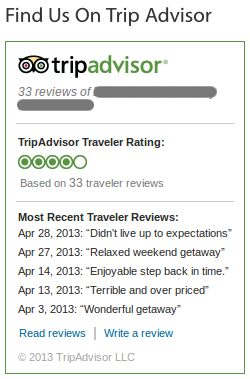
TripAdvisor is one of the most popular and influential travel websites. Many accommodation managers have embraced the TripAdvisor concept, and actively monitor reviews that guests post. This allows them to view feedback and provide a “management response” to any reviews that deserve another point of view, so that prospective guests can make an informed decision.
TripAdvisor allows you to implant “live” widgets on your website. There are a range of different types – some simply show that the accommodation is featured on TripAdvisor, while others go into more specifics, such as showing how many travellers gave a 5/5 rating. The one you really need to watch out for is the “review snippets” widgets as it shows the last (5 by default) recent reviews.
One of our clients has embedded the “review snippets” widget by TripAdvisor on their website. They are an acclaimed B&B – one of the top ranked their area. 90% of their reviewers have given them an overall “excellent” or “very good” rating. However, at this exact moment in time, this is what their “live” TripAdvisor widget is showing:

That widget is displayed prominently on every single page on their website for everyone to see. 2 out of the last 5 reviews are unfavourable. After seeing the phrases “didn’t live up to expectations” and “terrible and over priced”, you can imagine some people won’t spend a second longer to delve any deeper, and they will simply look elsewhere. That means lost bookings.
The problem here is those reviews have been taken out of context. While 2 out of 5 bad reviews are showing there, if you look at the bigger picture, that accommodation establishment has a total of 30 positive reviews out of a total of 33. In fact, half the reviewers gave the accommodation the highest possible score of 5 out of 5. Now that’s a pretty impressive achievement. Delve a little deeper, and each unfavourable rating has been followed up with a management response which casts significant doubt on the version of events described by the guests in question.
It’s a big risk implanting the TripAdvisor recent review snippets widget on your website. Any bad reviews from the 5 most recent really stand out and contain no explanation other than some derogatory catch phrase which is sure to put some people off, no matter how good all the others are. If you want to implant a TripAdvisor widget on your website, you’d be much wiser to choose one of the safer ones that don’t show the leading catch-phrase of guest reviews up-front. That way, if people want to see your reviews on TripAdivsor, they can go in and see the whole picture.


